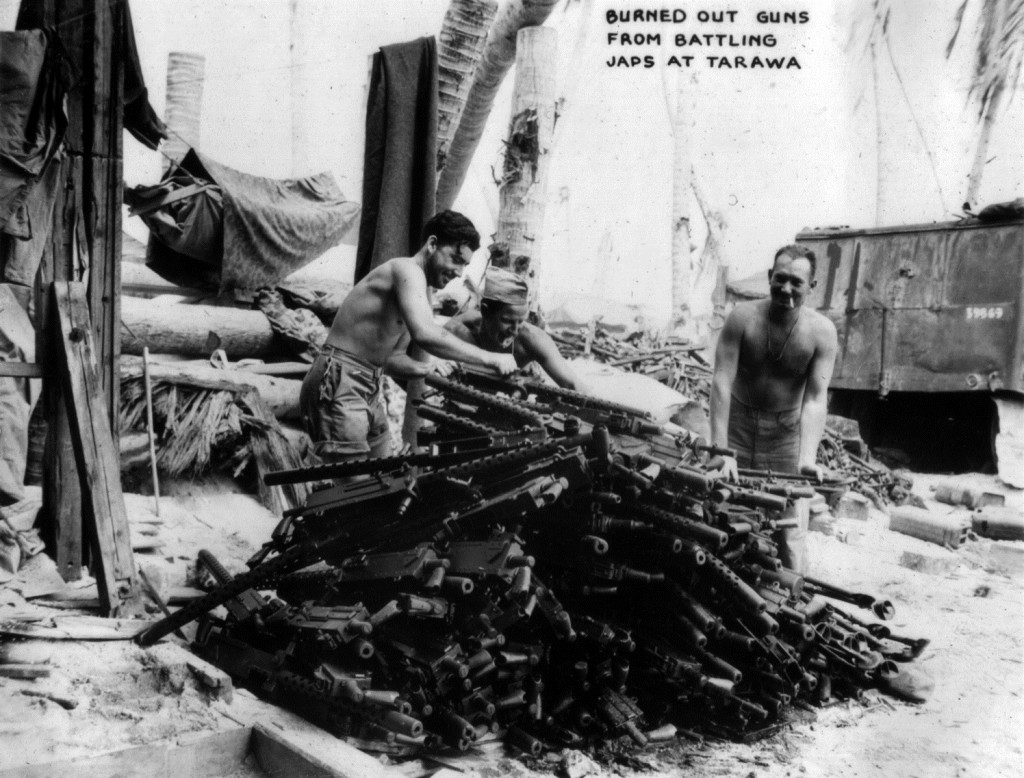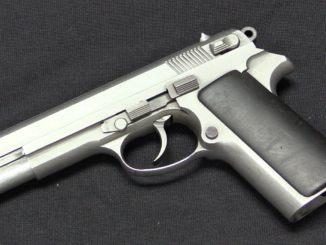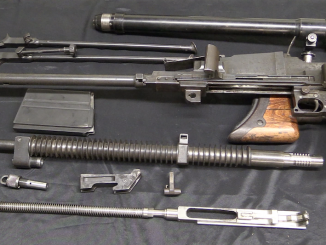

Towards the end of WWII, in 1944, the Japanese Navy developed a copy of the American M1 Garand rifle, chambered for the 7.7mm cartridge. This followed attempts to simply rebarrel captured US guns, which did […]

In the early 1970s, Colt wanted to develop a new military pistol so that it could offer a modern replacement for the venerable 1911. Colt Engineer Robert Roy designed the new gun in 1971, and […]

Introduced in 1937, the Type 97 was basically a copy of the ZB 26/30 pattern light machine gun adapted to use in Japanese tanks and armored cars. The adaptations included mounting an optical sight to […]
© 2025 Forgotten Weapons.
Site developed by Cardinal Acres Web Development.

Mute but telling evidence of the ferocity of the fighting on Tarawa — no quarter was asked or given by both sides.
And suddenly I completely understand the reason for a quick change barrel.
My late grandfather was a navy corpsman with the 6th regiment of the 2nd Marine division. D+1 Operation Galvanic, battle of Betio/Tarawa November 1943.
I have heard many stories along these lines that are apocryphal (but there is no reason to disbelieve them, really) about barrels becoming white-hot, the gunner or A-gunner claiming to see the individual bullets travel through the bore, etc. I suppose it’s quite easy to forget to keep your bursts at 6 to 9 rounds in the ferocity that ensues after the launch of a banzai charge…
Of course, you also go cyclic in the defense when firing your Final Protective Fire. I know a guy who equipped his perimeter bunker in Vietnam with a Minigun ammo can (this was the linked version), and one night when they called the FPF he fired The Whole Thing in one burst. Whereupon the barrel drooped at the end of the 1000-round burst. He had photos of the “limp” M60. The barrel could not be removed afterwards and the whole gun was DX’d. Most of those rounds must have keyholed wildly.
Personally, I was impressed anyone could get 1000 rounds out of an M60. Although the Ranger Batt guys always seemed to keep theirs running OK.
I am sure Ian would deeply enjoy it if you could get those pictures scanned onto the internet
Ian and me, too!
I was a pig (M60) gunner in the Army. 11B. I’ve seen barrels fired red. The rounds can be seen going thru the barrel then. It was some MPs using our range with us. Looong bursts. Their barrel didn’t droop, but the 5 in 1 they were using showed that it was keyholing badly before they quit firing it. Tracers flying around like fireworks.
what does a rounds going thru the barrel look like ?
One thing about the stack of Browning M1919A4’s in the photograph — the barrel jackets hide the real extent of the damage to the barrels themselves. I wonder if anyone took some follow-up pictures of the actual barrels after the armorers stripped off the jackets. That would have been most interesting.
They probably would have made decent chair legs lol…
The gun furthest to the left appears to have a drooped barrel and drooped jacket (lay a straight edge on screen to see droop)! On the right edge of the pile a little over halfway down, appears to be a gun with a water jacket. There is another pile of…something..in the background – on top is a rifle which appears to have a Garand stock, and a cup type grenade launcher?…What is in front of the man on the right’s right wrist?-a T&E unit? I love old pics like this…thank you so much!
The water-cooled gun is an M1917A1. The rifle in the pile in back is an M1918A2 BAR with the fore-end and trigger group removed, sitting on top of another M1919A4. And yes, that is the T&E unit of an M1919A4. There are also quite a few tripods in the pile.
At the 10:11 mark in the film ‘With the Marines at Tarawa’, you can see a Marine bringing up a new Browning to a machine gun position: http://www.youtube.com/watch?v=AopR3TnxffQ
You have good eyes there! thank you!
Without Tarawa I would never have been born. My mother’s fiancee died on the way to the beach. My mother met my father 3 years later and they married two years after that.
That’s quite a story, Tom. Thank you for sharing it.
A great photo. During the Battle of Milne Bay in New Guinea, the Australian Kittyhawks wore out the barrels of their 50 cals, mostly due to the effects of the coral sand that got into everything. Apparently the bores went from 12.7mm to 15mm over the course of the battle, but the guns were still effective. Maybe that is what happened to some of these Brownings.
@ PV :
I recall reading about this many years ago in an article about Australian ace Squadron Leader Keith William “Bluey” Truscott, DFC and Bar, who flew in the Battle Of Milne Bay during the New Guinea campaign, and thereafter in the defence of Darwin and the Northern Territories against Japanese aerial incursions.
I’ve been sitting here with a straightedge looking at barrel jackets, and I see droop in a number of them. Gawd! My Great Uncle fought at Tarawa, but was hesitant to ever speak of it. I’m beginning to see why. These piles of out-of-commision weapons speak volumes as to the intensity of the combat there. I wish the pile at the rear was in better focus, there is no telling what all it contains.
I don’t blame your great-uncle for not wanting to relive or explain his experiences. Tarawa was a bloodbath in its own right. It was at Tarawa that the now well-known photograph of dead American Marines lying in the surf on the landing beach was taken and widely-published Stateside, leading to a great deal of shock and emotional outrage among the general public. If nothing else, it brought home, in a single stark black-and-white image, the true price of war, even a so-called “good war”.
how long would it take to replace a burned out barrel and were there ever any Browning machine guns with quick change barrel ?
FN did design and incorporate a quick-change barrel for the FN Type D version of the BAR shortly after the end of World War Two.
If I recall correctly, quick-change barrels with pre-set headspacing and timing for the Browning MG’s only came about in the late 1970’s and early 1980’s, when a handful of firms such as Manroy Engineering ( UK ), Saco Defense Industries ( US, and now part of General Dynamics ) and FN Herstal developed basically similar variations on this theme for the 50-cal. M2HB HMG. This QCB feature has since trickled down to the M2HB’s direct descendants, such as the M2A1 and M2A2 ( which is made by U.S. Ordnance ). To my knowledge, no similar installation was fully developed or adopted for the smaller 30-cal. M1919A4, A6 or variations thereof.
Hope this helps a bit.
thanks for the info Earl Liew
what i am surprised about is that it took that long until a quick change barrel was developed , i was assuming that after a battle like the one of the picture that it became self evident that a quick change barrel was necessary and need it to be developed
The amount of time it would take to replace a burnt-out or defective standard barrel would depend on whether that barrel had overheated to the point where it had warped or welded itself to the receiver assembly. Assuming it had not, an experienced armorer or gunner would not take that long to carry out the change-out itself. The part that would actually be more time-consuming would be getting the head space and timing correctly adjusted and set.
The quick-change barrel, with pre-set, fixed head spacing and timing, eliminates this issue in addition to enabling very fast and easy barrel changes to be accomplished at will.
so its a job that can take anywhere from a couple minutes to the better part of a day ?
if the barrel had welded itself to the receiver assembly woude the gun be reparde or woude it be scrapt ? i am asuming that a lot of parts need to be replaced if that happens
Probably anywhere from several minutes to the better part of half an hour, including head space adjustments. As for seized / welded barrels, it would probably be more cost-efficient to simply scrap the gun altogether.